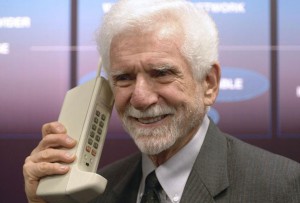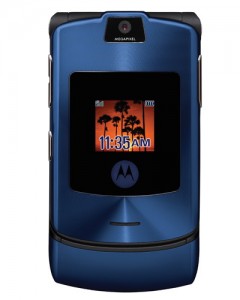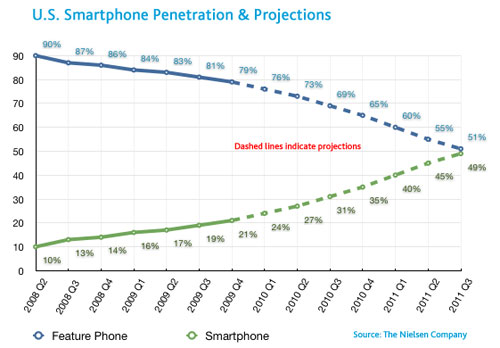The Ridiculous Growth of Smartphones
Mobile 101: This post is part of our educational series on mobile technology. If you are new to the smart phone/app arena, this series is a good place to start.
Smartphones and other “smart” mobile devices aren’t just growing, they’re growing at a ridiculous rate. I’ll spend the second half of this blog post sharing some statistics and links, but before I do, let’s talk context.
Mobile phones were first seen in the 70s.
Over time, the phones got smaller (thankfully), cheaper, and more powerful. Besides calls, these “feature phones” allowed people to “text” and take basic photos.
Today, the U.S. cell phone market is considered “saturated” – it’s hard to find someone who doesn’t have one.
Now we have a new wave of technology. Smartphones, which I’ll define as a phone which uses “apps”, are exploding in growth. I’ll give two reasons for this (there are many).
Growth Reason #1: A Smartphone is Your Third Arm
With maybe the exception of a wedding ring, not much else travels with you every day, everywhere you go. Calls, texts, e-mails, photos, appointments…my cell phone is a clearinghouse for a lot of my daily contact with the world.
A lot of people obsessively use their phone (I love this commercial):
When a new cellphone comes out with a new bell and whistle, it means that I can do more in my life. Given the option to get a phone which can use apps (i.e. do anything), people jump at the opportunity to add another finger to their third arm…or something.
Growth Reason #2: Phone Economics
When you pay $199 for an iPhone, you’re actually paying over $500 for that phone over time. A portion of your monthly cell phone bill pays for your phone.
But, once your two year contract is finished and your phone is paid off, your monthly rate doesn’t drop. If it did drop, people might keep using their old phones for years (gasp).
Instead, you’re encouraged to buy a new phone at a low upfront cost and a new two year contract. It’s an efficient mechanism that quickly cycles people towards newer technology.
Do you buy a refrigerator every two years? Toaster? Car? The adoption rate for smartphones is growing at a ridiculous pace due in part to these atypical phone economics.
The Numbers
If we looked back at the year 2011 ten years from now, I think we’d recognize a tremendous change in behavior — a tipping point — in computers, technology, and the “getting of information.” That change is “mobile.”
I read about this industry daily, but some of the statistics that I found when researching this post still amazed me. Look at the trajectory of smartphones in the below graph:
We think smartphone usage for our user demographic is even higher because most of our users are college graduates (more affluent and technology savvy).
Impressive stats:
- AdMob, the biggest supplier of ads on mobile devices, has seen a DOUBLING of ad impressions on popular smartphones (Android and Apple/iOS) in the last SIX MONTHS.
- Nielsen is predicting 80 MILLION new US smartphone users in just 2011. To put this in perspective, we have roughly 300 million people in this country.
- Google reports that there are over 300,000 Android phones activated PER DAY.
- Fortune predicts that smartphones will soon outsell COMPUTERS due to “insane” growth.
This trend isn’t stopping any time soon:
- Apple has partnered with Verizon to sell the iPhone open up their market to 90 million new subscribers.
- Microsoft has launched their new mobile software and are devoting over $500 million to promote it. The marketing budget for our mobile app is a little smaller.
- The VC (venture capital) community is focusing on and aggressively funding mobile companies.
And all of the above statistics don’t account for the rise of tablet devices, like the iPad, which I’ll cover in a future post.
What This Means for Your Organization
If your institution is looking to build loyalty with its alumni and members, you need to be forward thinking. As Wayne Gretzky once said, “Skate to where the puck is going to be, not where it has been.”
The future is mobile devices. Go “mobile” and you’ll be able to sustain the kind of smart communication that builds long-term loyalty to your institution.



